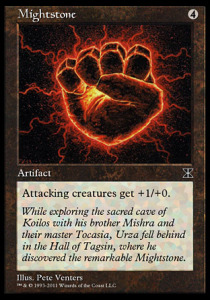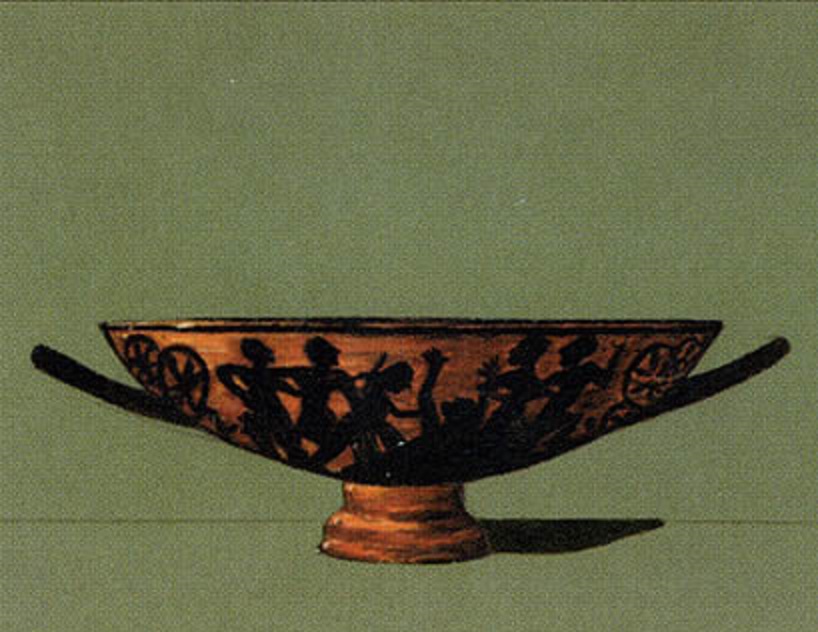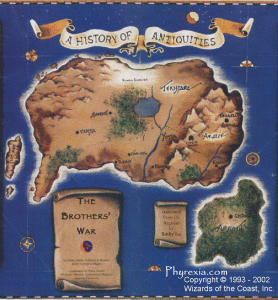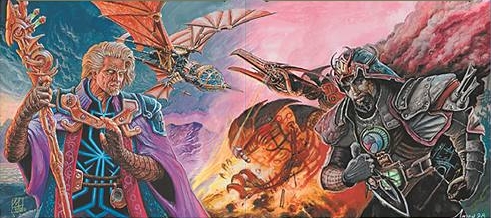Before we even discuss The Brothers’ War, let’s first recognize one fact. Magic: The Gathering the Card Series is prolific beyond measure. No matter what level of fan you are of the card series, you should immediately be able to recognize their ability to create immersion.
From the first MTG cards I ever held, I knew immediately they wanted to develop a lush fantasy world that could scatter one’s imagination and lull the player into a grandeur that could not be found in any other role playing experience then, now, or likely ever.
Historically, this pointed illusion is reserved for novels or perhaps film on some rare occasions, so its no surprise that when Wizards of the Coast saw the success of their series they decided to licenses a true epic, probably in their eyes meant to rival contemporary Robert Jordan’s.
Regardless, what we find in this continuum of literature is true fantasy legend. You can tell (obviously by looking at the publication dates) that this set was meant to transcend a few hundred pages, but have they succeeded?
The first book we are examining today is not the first book written under Magic: The Gathering IPs, but it is the first piece of the storyline they have infused in their earlier card sets.
The Brothers’ War was published in 1998, which is a very important note on the progression of both the company and the literature. If we examine the card set releases we see a peculiar notion that is clearly in the air of retrofit. A close eye notices the Antiquities set (1994) and later the Urza Block (1998 and forward.)
 What this reveals is that they realized the subtle text on the cards of the ever growing game was writing the story for them, and decided to take the next logical step in creation.
What this reveals is that they realized the subtle text on the cards of the ever growing game was writing the story for them, and decided to take the next logical step in creation.
Regardless of all this, you may wonder why this is relevant to a book review? I would argue the back story of the book’s publication is as important as the back story of Urza and Mishra, the two legendary artificers who were seemingly created as napkin art to be placed as anecdotes on passing card ideas. As important is the proliferation of these two Brothers is the legacy of each, especially when examined alongside the humble beginnings shared by the physical card game that would go on to be just as robust.
Luckily, the book itself, The Brothers’ War, a title shared with many other works of literature and film, is one to remember past its seemingly convoluted development.
Whether by stroke of genius or luck, the first chapter in this marathon storyline was penned by Jeff Grubb. Perhaps not a staple name in Fantasy, but certainly when you retrace the steps of the idea, has proven himself to be more than competent. What’s more interesting to me is that fact that he has been the navigator of multiple story beginnings, notably the Warcraft’s universe – no doubt a result of similar inspirations, being spawned and digested in a similar fashion.
In either light, Jeff Grubb pilots a fantastic expedition through the rich landscape of Terisiare. By intention surely, we get to learn about the vast peoples inhabiting said scape, and when you look years down the road you realize just how intriguing this actually is.
You see, the main focus is on Urza and Mishra, two brothers by blood who grew to develop a fierce rivalry. But when you look beneath the words, you realize this land has housed untold mysteries that drive the true storyline, and thus drive the legend that this first novel creates.
Perhaps I approached the novel with an advantage, knowing myself that this was not a stand alone work, and that the events in each chapter were seldom self-contained. Perhaps knowing what I knew from the Card equivalent and what was undoubtedly to come made Jeff Grubb transform from meager fantasy wordsmith into the second coming of Tolkien. But I firmly state that he simply played the role he was given in the MTG hierarchy, and did it to the absolute best of his – or anyone’s – ability.
The true power the novel contains does not stem from its machinations or “power stones,” but from the elegance of character development, often in needless places.
There are four main parts to the book, each detailing an important part of the life of Urza and Mishra, each containing characters that seldom last for 40 pages. 40 pages, and forever in my mind, as well as the annals of this world.
Surely this is what great fantasy literature is all about, and should come as no surprise to a seasoned reader, but I took care to preface the history of the actual publication before the history of Terisaire because of its profound relevance.
What you find within this book sets the stage for many to come, but is a great tale in its own right. Honestly, after reading through a large portion of this 10+ book time period, I can say that this one is the most powerful.
It maintains the true balance of fantasy and science fiction that MTG has always been about, and explains the inspiring moment when “Mana” is first examined by the populace of this troubled world.
Because of this, the captivating Urza and Mishra wholesomely play second fiddle in their own legend. The setting seems stationary for all until the last few pages, and suddenly the doors of this meager feudal situation get blown off in cataclysmic fashion, and you begin to realize just how breathtakingly massive this one plot can become.
Conclusion
An extremely well crafted tale.
I wholeheartedly recommend this book to any one of any age with a thirst for the fantastic. It may be a difficult read for a young child, but its never too early to get sucked into a work of art.
Find a digital copy, sit back and enjoy The Brothers’ War.
Score: 10/10.



